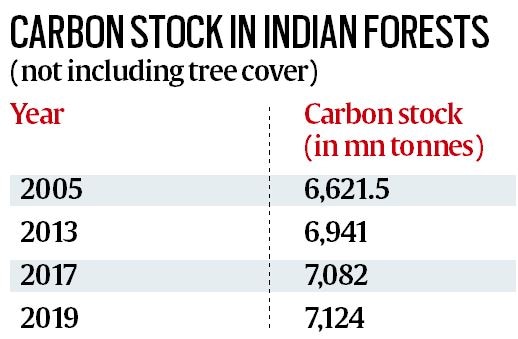Note4Students
From UPSC perspective, the following things are important :
Prelims level: Carbon Stock
Mains level: India's INDC

- The State of Forest Report (SFR) 2019 has shown an increase in the carbon stock trapped in Indian forests in the last two years.
- However it shows why it is going to be an uphill task for India in meeting one of its international obligations on climate change.
India’s carbon commitment
- India, as part of its contribution to the global fight against climate change, has committed itself to creating an “additional carbon sink of 2.5 to 3 billion tonnes of carbon dioxide equivalent” by 2030.
- That is one of the three targets India has set for itself in its climate action plan, called Nationally Determined Contributions, or NDCs, that every country has to submit under the 2015 Paris Agreement.
- The other two relate to an improvement in emissions intensity and an increase in renewable energy deployment.
- India has said it would reduce its emissions intensity (emissions per unit of GDP) by 33% to 35% by 2030 compared to 2005.
- It has also promised to ensure that at least 40% of its cumulative electricity generation in 2030 would be done through renewable energy.
What is the relationship between forests and carbon?
- Forests, by absorbing carbon dioxide from the atmosphere for the process of photosynthesis, act as a natural sink of carbon.
- Together with oceans, forests absorb nearly half of global annual carbon dioxide emissions.
- In fact, the carbon currently stored in the forests exceeds all the carbon emitted in the atmosphere since the start of the industrial age.
- An increase in the forest area is thus one of the most effective ways of reducing the emissions that accumulate in the atmosphere every year.
How do the latest forest data translate into carbon equivalent?
- The latest forest survey shows that the carbon stock in India’s forests (not including tree cover outside of forest areas) have increased from 7.08 billion tonnes in 2017.
- This translates into 26.14 billion tonnes of carbon dioxide equivalent as of now.
- It is estimated that India’s tree cover outside of forests would contribute another couple of billion of tonnes of carbon dioxide equivalent.
How challenging does this make it for India in meeting its target?
- An assessment by the Forest Survey of India (FSI) last year had projected that, by 2030, the carbon stock in forests as well as tree cover was likely to reach 31.87 billion tonnes of CO2 equivalent.
- An additional 2.5 to 3 billion tonnes of sink, as India has promised to do, would mean taking the size of the sink close to 35 billion tonnes of CO2 equivalent.
- Considering the rate of growth of the carbon sink in the last few years, that is quite a stiff target India has set for itself.
- In the last two years, the carbon sink has grown by just about 0.6%%. Even compared to 2005, the size of carbon sink has increased by barely 7.5%.
- To meet its NDC target, even with most optimistic estimates of carbon stock trapped in trees outside of forest areas, the sink has to grow by at least 15% to 20% over the next ten-year period.
Way Forward
- There are two key decisions to be made in this regard — selection of the baseline year, and addition of the contribution of the agriculture sector to carbon sink.
- When India announced its NDC in 2015, it did not mention the baseline year.
- India’s emissions intensity target uses a 2005 baseline, so there is an argument that the forest target should also have the same baseline.
- But there is a strong demand for a 2015 baseline as well, so that it results in some concrete progress in adding new forest cover.
- The NDC specifically mentions that and “additional” 2.5 to 3 billion tonnes of carbon sink would be created through additional forest and tree cover by 2030 MoEFCC insist that tree cover outside forest areas must include agriculture as well.
- India would also have to specify whether it wants to count the carbon sink in the agriculture sector in its target.
Get an IAS/IPS ranker as your 1: 1 personal mentor for UPSC 2024
